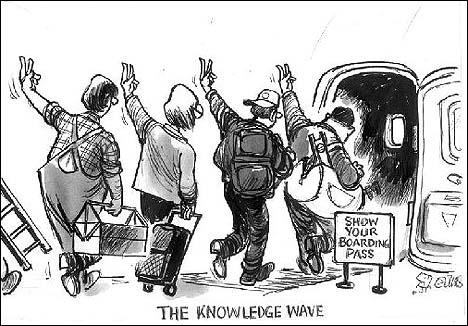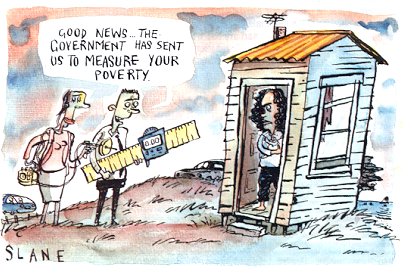

- AVERAGE NEW ZEALANDER IS WORSE OFF
The income of the average New Zealander is worse off now than two decades ago, and the gap between high and low-income households is widening, according to a new report published by the Ministry of Social Policy. The report outlines household income trends from 1982 to 1998. It shows that the average annual disposable (after tax) income per household has dropped by almost 10%.During this period, the gap between rich and poor widened by 17%. In 1988 the top 20% of households earned 2.3 times more than the bottom 20%, and ten years later they earned 2.7 times more. The 1998 average disposable income was $31,470.
- Analysis of annual household economic survey data during the 82-98 period shows
that, when inflation and tax were taken into account, average disposable household incomes
fell during the 1980s and well into the mid 1990s. This largely reflected the economic recession
at the time which led to a rise in unemployment, and an increase in numbers on benefits. This
trend then recovered strongly, and by 1998 household incomes were at levels approaching those of
the early 1980s.
The gap between rich and poor has widened because incomes at the top level have recovered more strongly than incomes at the bottom of the scale (see table, below). The report shows that this pattern holds regardless of whether before-tax or after-tax income is considered and regardless of whether or not adjustments are made for household size.

Distributions and Disparity
— New Zealand Household Incomes
by Mary Mowbray
(published by the Information and Analysis Group, Ministry of Social Policy 2001)
ISBN 0-478-25114-9
available from the MOSP website at www.mosp.govt.nz/publications/
docs/distributionsdisparity.pdf
download full document
PDF file (68 pg, 311 KB)
A hard copy can be requested from information@mosp.govt.nz or from the Communications Unit, Ministry of Social Policy, Private Bag 39993, Wellington, phone 04-916-3860, fax 04-916-3910.PERCENTAGE CHANGE IN DISPOSABLE (after tax) INCOMES Percentage Change Overall Percentiles 1982 - 1988 1988 - 1993 1993 - 1998 1982 - 1998 90 -3.9 -0.5 -10.8 6.0 75 -6.9 -10.7 15.9 -3.5 Median 50 -7.7 -14.4 12.7 -10.9 25 -4.9 -18.0 10.1 -14.1 10 -10.5 -9.7 4.4 -15.7 - INCOME DISTRIBUTION AND DISPARITY
Highlights from the Ministry of Social Policy Distributions and Disparity —New Zealand Household Incomes report.Beneficiaries. More than 40% of households with a beneficiary member had disposable incomes that placed them in the bottom fifth of the income distribution in 1998.
Throughout the 90s the incomes of these households have been less than 60% of the average income for all households. Before the 1991 benefit cuts, average incomes for these households were generally more than two-thirds of the average for all households.
Children. Households with children and dependent young people among their members have tended to cluster in the bottom two-fifths of the income distribution over the period covered by the report.
High proportions of the child population lived in the bottom fifth of households in the mid-90s (33%). This proportion had dropped back to the level of the late '80s by 1998 (24%).
Maori. Households with adult Maori members tended to have below average incomes throughout the period covered by the report. Such households tended to suffer a particularly large fall in income through from the late 1980s to the low point for incomes between 1992 and 1994.
This effect appears to be strongly related to levels of unemployment experienced by a younger population that is much more reliant on income from paid work than some other groups. The position of these Maori households had improved again through to 1998, with a return to income levels nearing those of the late 80s.
A key factor in this improvement has been an increase in the overall household hours worked. However, hours worked by households with Maori adult members tend to yield a lower income than equivalent hours worked by other households.
Renters. Housing rentals imposed an increasing burden on low-income households. Although renters only made up a quarter of all households in 1998, over 40% of the households in the lowest fifth of the income distribution were renters.
An increasing proportion of households in the lowest fifth paid more than 30% of their income on rent (17% in 1988, 44% in 1998).
Superannuitants. Although incomes of households with beneficiary members fell in the early '90s, average incomes of superannuitant households did not. NZ Superannuation was not affected by rate cuts in 1991, and the introduction of living alone allowances in 1992 lifted incomes for some.
Beneficiary households consequently displaced many superannuitant households from the lowest fifth of the income distribution as the relative income position of beneficiary households deteriorated. In 1988, nearly half of the households in the lowest fifth of the income distribution comprised one or two adults receiving NZ Superannuation. By 1998 this proportion had dropped to less than a third.
Women. Average incomes for households in which all the adults were women were consistently lower than the average incomes of households in which all the adults were men, and lower than households with mixed adult gender, regardless of whether there were children or dependent young people in the household. This gap widened during the '90s.
Sources — Distributions and Disparity - New Zealand Household Income by Ministry of Social Policy; The Dominion, New Zealand Herald 27 July 2001 "Average NZ household worse off now than 20 years ago" by Marianne Betts, NZPA; Ministry of Social Policy Press Release 26 July 2001 " Average household incomes increasing, but households with children worse off — report"
- TRACKING SCHOOL LEAVERS
The government is to start tracking the career paths of secondary school leavers, following concerns raised by the Mayors Taskforce for Jobs that too many young people under 18 years may be leaving school and disappearing from any systems of vocational support.A "Destinations and Tracking" pilot project will be set up in Christchurch and Porirua this year, to collect data from approximately 2,000 secondary school leavers. The project will record the intended destinations of school-leavers at the end of the year, and then early next year, this information will be matched against the actual destinations.
The project is being undertaken by Careers Services in partnership with Skill New Zealand. The final data will be used within schools to enhance their career education programmes, and to help identify tools and approaches to vocational support that may be more successful with young people.
-
 Porirua Mayor Jenny Brash says that there is a nationwide problem of young people
dropping out of school at aged 16 and then disappearing from any systems of support. Brash:
"There are too many young people leaving school without any qualifications. By the time they get to
18 years, and enrol with Winz or on a training course, its just that much harder to get them
motivated to work. Tracking these young people will be absolutely essential step if our Taskforce
is going to achieve its goal of getting all young people under 25 years into work or training
by 2005. The trouble is, at the moment, nobody really knows where these young people are
and what they are doing..."
Porirua Mayor Jenny Brash says that there is a nationwide problem of young people
dropping out of school at aged 16 and then disappearing from any systems of support. Brash:
"There are too many young people leaving school without any qualifications. By the time they get to
18 years, and enrol with Winz or on a training course, its just that much harder to get them
motivated to work. Tracking these young people will be absolutely essential step if our Taskforce
is going to achieve its goal of getting all young people under 25 years into work or training
by 2005. The trouble is, at the moment, nobody really knows where these young people are
and what they are doing..."
Christchurch Mayor and Taskforce chairman Garry Moore agrees: "We don't want to see our young people going straight from school to the dole. We've got to keep in touch with them when they leave school ... and make sure they get into the ethos of working."
Sources — Vivian Hutchinson interviews with Mayors Garry Moore and Jenny Brash 30 July 2001. Press Release NZ government 28 June 2001 "Tracking secondary school leavers career options"
- REGIONAL DEVELOPMENT CONFERENCE
Last month the Mayors Taskforce for Jobs met with Minister of Economic Development Jim Anderton and Minister of Employment Steve Maharey to discuss progress on their goals and the Memorandum of Understanding (signed between the government and the Taskforce).Jim Anderton used the occasion to announce a major Regional Development Conference which will be held in Rotorua on 28-29 November 2001. The Conference is expected to attract over 500 delegates including keynote speakers who are local and international regional development experts.
Anderton sees the conference as an opportunity for economic development workers, local authority representatives, iwi and local business leaders to see what is working and how it will apply in their own regions. Anderton: "I have been on 39 regional visits across New Zealand and it is clear those involved in regional development have a lot to teach each other, and they want an opportunity to network and share knowledge and ideas. This conference will provide a significant opportunity for this to take place..."
- Anderton reports that his Regional Partnerships Programme is already working to
build strong economic networks. Under the programme, regions can apply for up to $100,000 for
the development of regional plans and up to $100,000 for creating the capability to implement
the plans. Funding of up to $2 million per region is available to contribute to major regional
initiatives from the strategies developed in the first two stages. To date, 14 regions have secured
grants amounting to $1.3 million, and $2.2 million has been committed to 19 regional partnerships.
Source — Press Release Jim Anderton 17 July 2001 "Conference to boost Regional Development"
- BRING THE HASSLE BACK
 A National Government would "bring the hassle back" for teenage mothers and
people sitting on the dole smoking dope, according to its Social Welfare spokesman Bob
Simcock. Speaking at the start of the National Party's annual conference last month, Simcock
launched into an attack on beneficiaries, saying some of their life choices were dumb and needed to
be discouraged. (see Voices, this issue).
A National Government would "bring the hassle back" for teenage mothers and
people sitting on the dole smoking dope, according to its Social Welfare spokesman Bob
Simcock. Speaking at the start of the National Party's annual conference last month, Simcock
launched into an attack on beneficiaries, saying some of their life choices were dumb and needed to
be discouraged. (see Voices, this issue).
In a snipe at Social Welfare Minister's pre-election promise to "get rid of the hassle", Simcock signalled that a National government would bring back the work-for-the-dole strategy that Labour had dropped. Simcock reported that he had heard from work scheme co-ordinators that the attitude of people on them changed as soon as they heard that the work-for-the-dole scheme would be dropped: "They wouldn't turn up on a wet day, and so on..."
He told the conference: "For people who are stuck on welfare, for people who are poorly motivated, for people who have other sources of income and for people who are just too comfortable on the benefit, National will bring the hassle back..."
Bob Simcock also confirmed that the National Party is looking at welfare policies which include a time limit on benefits and a form of unemployment insurance.
Source — New Zealand Herald 21 July 2001 "National MP hoes into dole lifestyle" by Bernard Orsman; 23 July 2001 "Simcock defends speech". The Daily News 23 July 2001 "National targets welfare, child abuse" by Tracy Watkins
- MYTHS OF THE DPB MUMS
Bob Simcock's harangue against teenage mothers living on the Domestic Purposes Benefit (DPB), has been immediately challenged by research released by a Massey University research fellow, Helen Wilson. Wilson's research dispels the myth that teenage birth rates have swelled since the DPB was introduced in 1973. In fact, the rate has more than halved since that time, a result of the widespread use of the contraceptive pill, and more women choosing abortion.The figures: Teenage birthrates had halved since 1972 from 69 in 1,000 women to 29.3 in 1,000 in 1999. Teenage mothers now make up just 2.7% of DPB beneficiaries. Also, sole parents spend an average of only three and a half years on the benefit.
- Helen Wilson says the figures challenged the popular notion that the DPB was
responsible for encouraging teenagers to have babies. She argues that two commonly accepted myths —
that teenage birthrates had swelled since the domestic purposes benefit was introduced in 1973
and that teenage mothers took a disproportionate amount of benefit payments — have had
major repercussions for young women struggling to raise their children.
Wilson, whose background includes 12 years as a Plunket nurse, does point out however that New Zealand still has a relatively high teenage birth rate compared with other developed nations, and was second only to the United States for most of the past decade. She says teenage pregnancy has been considered problematic since the 1940s when it was seen as a moral and later a medical problem. Today it is seen as a social problem.
Source — New Zealand Herald 25 July 2001 "Research explodes myths of DPB mums" by Josie Clarke
- US SOLE PARENTS ALSO REDUCING
A study of welfare beneficiaries in the United States has also found the number of solo parents has been reducing. But the shift is being credited to the 1996 US government welfare reforms which introduced a time limit of five-years on people claiming a benefit as well as making "workfare" or work-for-the-dole compulsory. The legislation also required women applying for benefits to identify their children's father.Researchers Allen Dupree and Wendell Primus report that there has been an 8% drop in the number of solo parent claiming benefits in the US. Their study did not investigate the causes of the decline in solo parent beneficiaries but the authors (who say they opposed the 1996 reforms) believe the legislative changes have certainly had an impact.
Dupree and Primus say there are a number of other factors that have changed over the period. One is that most states have dropped penalties for couples seeking state assistance, a paradox that had encouraged families to separate. The authors say other contributing factors in the drop in beneficiary numbers may be the stronger US economy, lower unemployment and increases in wages at the bottom end of the income scale.
- While the US reforms may be working for some, the five-year time limits are now up
for the first wave of welfare recipients to be affected by the legislation. Stephen Bradley, a
member of Community Voices Heard in New York City, reports that it is solo parents, mostly
women, who are having the greatest difficulties and are ending up in homeless shelters.
Bradley says that many city-run childcare centres are inadequate and some mothers refuse to leave their kids in them to do "workfare". Bradley: "The mother has to make a choice to take the benefit and go to work and leave the child at home. Women are staying home and they are kicking them off welfare. The homeless shelters are bursting at the seams with single women."
Source —The Dominion 7 July 2001 "Solo mum decline linked to reforms" from the New York Times
- POLICE RECRUITMENT BLUES
The Police are to spend four times as much as they did last year on recruitment. National opposition MP Tony Ryall argues that this is because of a big drop off in interest in joining the force, in the wake of the Police budget crisis.Ryall says that when the government promised to make recruits pay for their training, the level of enquiries from potential recruits plummeted. Ryall: "Many of those potential police officers pulled out and said forget it. Then, six months ago, the government cancelled the training of 240 police officers in order to save $5 million. Not only did this sap morale amongst current staff, it scared off a whole load of good potential recruits..."
Police now plan to spend a million dollars on recruitment activities this year, compared to $281,000 last year. The Commissioner of Police has confirmed to Ryall that the current recruitment drive will only maintain existing sworn police numbers, and that the million dollar campaign aims to recruit 400 extra staff. Ryall: "Last financial year it cost around $650 for each recruit. This year it'll be $2,500 each. This should not have happened..."
Source — Press Release Tony Ryall 2 July 2001 "Million Dollar Recruitment Panic"
- HELP FOR IT IMMIGRANTS
A new programme designed to assist skilled immigrants into productive work has registered more than 120 Information Technology professionals. Only two months old, the Auckland Chamber of Commerce scheme is meant to match the shortage of IT workers with the large number of underemployed immigrants with IT skills. Employers and immigrants can register at www.newkiwisco.nz or contact Leah Gates at: lgates@chamber.co.nz or phone (09) 309 6100.Meanwhile, another service for immigrants which helps fast-track residency applications for people with IT skills has been operating since 1999. The Information Technology Association of NZ (Itanz) provides letters of support that are recognised by the Immigration Service as supporting evidence to an immigration application. Jim O'Neill from Itanz says that more than 370 people have received letters of support from the service. O'Neill says that 70% of their successful residency applicants came from South Africa and the UK and most applicants had already arrived in NZ on visitor's visas and wanted to acquire residency status.
Sources — Press Release 21 June 2001 "IT skills prominent among migrants seeking work" by Auckland Chamber of Commerce; NZ Info Tech 16 July 2001 "Itanz letters help 370 would-be immigrants" by Amanda Wells

Malcolm Evans — New Zealand Herald - COMING BACK TO THE GOOD LIFE
Skilled workers who have returned to NZ after working overseas are looking for the "good life" with family and friends, according to a recent on-line survey by the recruitment company TMP Worldwide.The survey asked 750 people a series of questions on the reasons for working in NZ and for working overseas. Lifestyle factors such as the easy access to outdoor pursuits (82%), reduced commuting and travel time (36%) and the favourable climate and environment (60%) were listed as the attractive features that brought the expats home.
TMP National Director of Strategy Dr Kaye McAulay says that the survey shows that NZ needs to promote itself so that it becomes an attractive stop off point for the travelling global talent pool. Dr McAulay: "We are aware of at least 80,000 NZ'ers in Great Britain who are registered with Monster.com. Industry and government must assist with developing strategies to attract the talent back here."
- The traditional "OE" destination of Great Britain still attracts Kiwis looking to work
overseas. 56% of those surveyed who have already worked outside NZ have done so in the UK
followed by Australia (53%), USA (28%) and Asia (21%).
The pool of countries available for New Zealanders to work in is growing as more countries open their doors to skilled workers. In the last year alone, Italy, Sweden, Holland and France have joined the more traditional Commonwealth "OE" destinations as being places that New Zealanders can acquire working visas.
Dr McAulay: "The promise of higher remuneration, a broader variety of roles and more challenging projects are the recurring reasons cited by respondees for taking up work opportunities overseas. Many stated that the lure of the high dollars being offered off-shore were an incentive to go and earn money to pay off student loans and to save for mortgages. High income earners — the skilled people that New Zealand needs to move towards economic prosperity — also responded that escaping domestic high tax rates was an incentive to work off-shore..."
Respondents to the survey offered suggestions to the government in order to retain skilled workers: reduce the cost of tertiary education; better recognise the qualifications of immigrants; reduce the tax on higher incomes; and look at an apprenticeship system for recent graduates who could not find work.
Source — Press Release TMP Worldwide 19 July 2001 "Home Is Where The Heart Is - Not The Dollars"
Voices
- ON BRINGING THE HASSLE BACK
" It is wrong to sit on the dole in Gisborne when there is a good job available if only you are willing to get off the dope.
" It is wrong to accept the dole when you have another, undeclared income.
" It is wrong for a child to become a parent when they are 14, and it is very wrong for parents not to do everything they can to stop that happening.
" A family where two mature committed parents work to make a life for their children is preferable to a family that consists of a 16-year-old mother with two children..."
— Bob Simcock MP, National Party spokesperson on Social Welfare" Why Gisborne? Why not Northland or Southland, or the Chatham Islands or better still why name a place at all ?
" The reality is that neither Mr Simcock nor his National colleagues would know much about Gisborne because I doubt they have bothered to come here and talk to those who understand the big picture.
" Nor, when they were in government for nine years, did they do anything in the wider social field. Instead they perpetuated a situation which they are now experts in changing..."
— John Clarke, Mayor of Gisborne" Research on teenage mothers does not bear out the negative images that the media often portray. I wonder if it's being driven by the fact that middle-class white women are having their babies much later. Is this now seen as the norm and everything else is a problem?"
— Helen Wilson, Massey University's Centre for Public Health Research" To my mind the tragedy is that more than two thirds of all of the young women who went onto the DPB as teenagers have stayed there. Some have been on the DPB for almost 30 years, having had many more children. None of these women has had the full support of the fathers. Many of these kids have grown up without a dad in their lives.
" Statistically, mature women who were perhaps in a relationship which failed, go on the DPB for a relatively short time — till they get back on their feet. But not teenage mums. It is clearly a trap for them. Not only that, but new research shows that being born to a teenage mum on the DPB significantly disadvantages children."
— Muriel Newman, Act Party spokesperson on Social Welfare" Through important debates such as this, it is important not to generalise. Everyone in a group is not in the same situation. They have individual requirements and problems to be resolved. There has to be a spirit of trust and support in how social security is administered.
" Taking a position of misplaced moral judgement and removing income support from a vulnerable section of the population will not help. The government and the law cannot discriminate on perceived moral grounds..."
— Steve Maharey, Minister of Social Services" Mr Maharey repeatedly claims, as do other politicians, that the average time spent on the DPB is 3.7 years. What he has omitted to add is that this is per spell on the DPB, not per individual. Winz figures currently show that 4,123 of the people that went off the DPB in 2000 have already signed back on.
" Mr Maharey would like us to envisage a picture of a typical DPB recipient as a female leaving a relationship and temporarily using the benefit till she can find work. Some do fit this bill but we have no way of knowing how many. Nor do we know how many are habitually "on and off" the DPB. What we do know is that over 14,000 women have declined naming the father of their child to Winz. One can only speculate as to whether they will decline the same information to their child..."
— Lindsay Mitchell, Campaigners for the Abolition of the DPB" Social Services Minister Steve Maharey and the Government have sent the strong message that people are welcome to live on welfare and that this is a better option than working for those in low-paid jobs. Mr Maharey has increased benefits, abolished the limp requirement of the last government that able-bodied beneficiaries might do some community work in return for the dole, even made certain that only beneficiaries, not workers paid less than them, have access to the community services card's cheap doctor's visits.
" With an already generous welfare system made even more so, it is no wonder that there are more beneficiaries of working age now than when unemployment reached its post-World War II peak in 1991. A decade ago, with the unemployment rate at 10.9%, 294,000 were on the dole or the domestic purposes, sickness and invalids benefits. Today, with unemployment halved to 5.4%and 352,000 more people with jobs than in 1991, a staggering 357,000 working-age people live on welfare. The budget predicted numbers would reach 382,000 by 2005, an indictment of Mr Maharey's policies.
" The Government's priorities are ridiculously misplaced. Welfare should be a safety net, not a long-term way of life for the indolent. Most people on welfare draw benefits for a short time after they lose their jobs, fall seriously ill, are deserted by their partner or similar misfortunes of life. That is what welfare is for.
" But increasing numbers of people have lived on benefits for years. Some sole parents have drawn the DPB almost since its inception in 1973. While the average length of time spent on the DPB is only 3.7 years, it was 2.5 years 20 years ago, and 23,010 people of the 110,000 currently drawing it have done so for more than five years..."
— Editorial in The Dominion 27 June 2001 "Welfare out of control"

Top of Page
This Letter's Main Page
Stats | Subscribe | Index |
The Jobs Letter Home Page | The Website Home Page
jrt@jobsletter.org.nz
The Jobs Research Trust -- a not-for-profit Charitable Trust
constituted in 1994
We publish The Jobs Letter

Essential Information on an Essential Issue

Letter No.150
2 August, 2001











